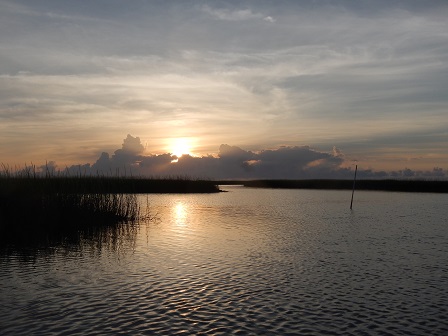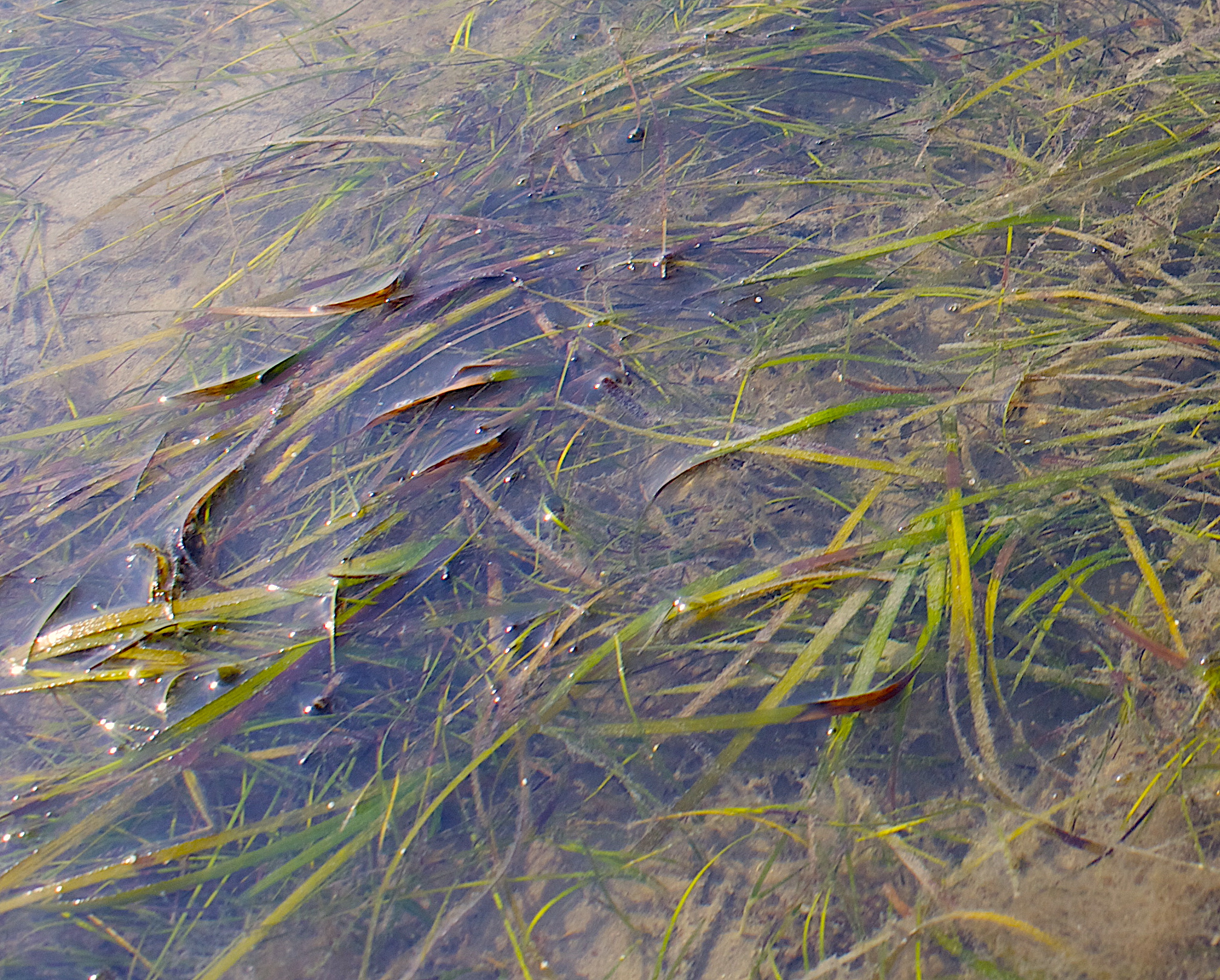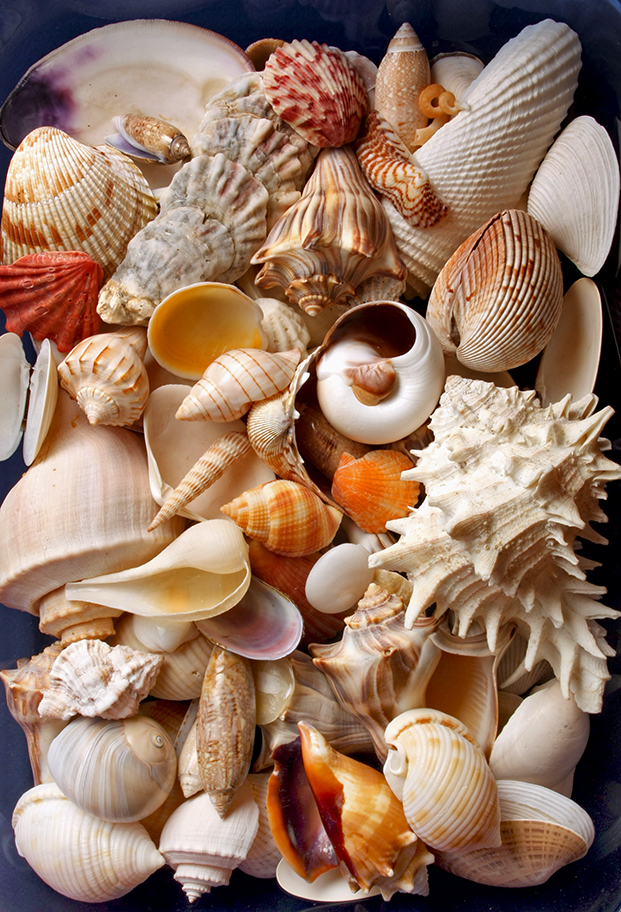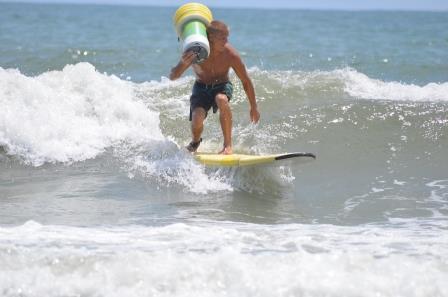Counting Kings: Text Reporting Catches On

Text messaging, a once cryptic communication mode that only teens could decipher, has gone mainstream. The rest of the world not only has cracked the code, but also has adapted the rapid-fire shorthand format for myriad purposes — from managing a business to starting a revolution.
Now Scott Baker, North Carolina Sea Grant fisheries specialist, has started a data revolution of sorts by turning the ordinary cell phone technology into a citizen science tool. He designed RecText to evaluate how tournament anglers might use their personal cell phones to text message catch and effort information directly to a computer database.
His 2007 pilot project with software developer Ian Oeschger was funded by a Sea Grant minigrant. Follow-up testing at North Carolina fishing tournaments has provided an electronic-reporting framework that fishery managers are considering here, as well as at federal and state levels.

The data-texting concept has gained traction as Baker and his project team road-tested RecText at four king mackerel tournaments in 2009 and two in 2010 — pitching the electronic self-reporting idea to nearly 2,500 registered anglers.
“King mackerel are the focus of at least 18 of the 46 fishing tournaments listed by the N.C. Division of Marine Fisheries. Therefore, tournaments can have big impacts on a fishery,” Baker explains.
In fact, DMF estimates that tournament harvests account for between 30 and 50 percent of total king mackerel recreational landings, Baker says.
Traditionally, DMF tracks recreational fishing catch through a combination of phone calls and dockside surveys of saltwater license holders. But, while DMF carries out biological sampling at tournaments, the agency has not conducted catch and effort surveys at tournaments in recent years.
“RecText could help the division get a better handle on actual numbers being harvested in the tournament setting. And anglers would have an opportunity to become part of the fishery management process,” he says.
Baker’s study, “Text-Messaging: A Novel Approach to Collect Catch and Effort Information from North Carolina King Mackerel Tournament Anglers,” was among the first to be funded by the Coastal Recreational Fishing License Fund. The N.C. Marine Fisheries Commission and the N.C. Fish and Wildlife Commission administer the grant program. Funded projects address recreational fishing needs and issues, such as fishery stock management and recreational waterfront access.
A HOW-TO QUICK COURSE
The goal at each tournament was for the RecText team to reach as many registered anglers as possible with a “how-to” quick course. Team members included Sara Mirabilio, Sea Grant fisheries specialist; Lisa Humphrey, Sea Grant administrative assistant; and Jon Vanderfleet and Joe Facendola, University of North Carolina Wilmington research assistants. They donned bright green T-shirts with RecText logos, staffed educational tents, and mingled in crowds of excited participants.
Tournament directors talked up RecText and gave Baker the mic at pre-tourney captains’ dinners and during registration.
At four tournaments, RecText survey kits were randomly distributed. At two events, tournament directors included the kits in each captain’s bag. In all, RecText kits were on board 967 boats. And, there was the promise of a cash prize for texting the catch and effort information.
“We wanted every boat that participated in the tournament to have an opportunity to contribute data, not just the boats that weighed in fish for competition. We sent text messages to boaters during the active fishing time to remind them to text their catch,” Baker recalls.
“We had great cooperation from all the tournament directors. The Raleigh Saltwater Sportfishing Club folks put a ‘Text Your Catch’ reminder sign on their check-in boat and cruised up and down the line of boats approaching the weigh station at Atlantic Beach,” he adds.
“No two tournaments were alike,” Mirabilio points out. “So, we tried different things at different tournaments.” At the U.S. Open King Mackerel Tournament in Southport, she walked through the crowds wearing a sandwich board sign that said, ‘Got Fish? Text Info. Win Cash.’
“We stressed the importance of reporting all the numbers, not just what they brought to the weigh-in. We wanted them to report what was caught, kept or released, and not just king mackerel, but all species. And if they didn’t catch a thing, we wanted them to report that, too,” Mirabilio says.
Given the hectic environment surrounding the team’s oral informational delivery, the well-designed RecText kit provided essential backup educational material. The kit consisted of a welcome letter explaining the importance of the study and step-by-step instructions for measuring, identifying and reporting catch data via text messaging. A wallet card provided codes to use in the text message and a sample report. The kit even included a fabric tape measure and pencil.
In 2009, tournament RecText kits included text-messaging format instructions along with a paper survey with instructions for gathering and submitting the catch and effort data. The paper version was similar to the mid-1990s DMF survey. In 2010, participants’ kits had only text-messaging instructions.
Interestingly, Baker says, the calculated number of king mackerel kept per angler per hour fished was not significantly different between the 1990s and recent study periods. And reports of “zero king mackerel” from both the earlier survey and the RecText project confirmed that both successful and unsuccessful anglers participated in the surveys.
PRACTICE MAKES PERFECT
“All in all, it was a successful first attempt at the tournament scale,” Baker says. The results indicate that anglers participating in the survey were able to adapt to the RecText-only participation method in 2010 versus the 2009 study year in which both paper and texting methods were offered.
Baker points to the fact that overall data collection survey participation rate was almost identical in both years —14.4 percent in 2009 and 14.8 percent in 2010.
Problems encountered included discrepancies in fish lengths reported by anglers versus those taken by tournament officials. Also, a considerable number of typographical errors were made.
The text-messaging language for the RecText tournament setting was adapted from the Sea Grant pilot study Baker conducted with six charter boat captains in the Wilmington area. Baker and Oeschger designed a way for charter boat captains to use prepaid mobile phones to text their fishing reports using a special code to Twitter — then, a little-known online text-messaging service.
Twitter worked well in the small-scale trial. “With just six people reporting on a regular basis, there were very few errors, even though two of the captains had never texted before,” Baker recalls.
The Twitter pilot won the approval of participating charter captains; piqued the interest of DMF, science bloggers and citizen science advocates; and encouraged Baker to explore a broader application for real-time reporting.
“Purchasing prepaid phones for all tournament participants was out of the question. Also, Twitter requires individuals to register before using the service, making our pilot approach difficult to replicate on a large scale for non-Twitter users.
Not wanting to exclude any of the thousands of tournament anglers from serving as potential data collectors, we decided to refine our approach, using the device that 85 percent of all American’s own — a standard cell phone capable of text messaging,” Baker explains.
“We used EZ Texting, a commercial text message aggregator, for its economy and ease of use. Anybody could send a message directly to the website using the key word that we rented for the 18-month study period,” he says.
“The instant aspect of electronic reporting is very appealing. Citizen scientists can see the results and feel good about having made a contribution,” Mirabilio adds.
THE FUTURE IS NOW
Randy Gregory, DMF marine biologist, is excited about the future applications of technology in assessing and managing recreational fish populations. Gregory is the species leader for king mackerel and also oversees the Governor’s Cup Program for billfish tournaments.
Tournament catch information is virtually unknown and difficult to get, he notes. “The angler usually brings in only the biggest for weigh-in competition. But if he catches 12, keeps six, and only brings one to scale for the prize, then the other six are not in the count and the harvest numbers are skewed. RecText, on the other hand, captures all the numbers we need,” Gregory says.
“It took someone like Scott to step out for the first time and prepare the way for the next steps and new applications. He took the old, time-consuming paper survey and brought it into the 21st century and showed we could text vital information directly to a database for the folks who do assessments,” Gregory adds.
Baker’s ideas are catching on since he made presentations about his 2007 pilot study for an international web forum sponsored by the Alaska Department of Fish and Game and at the American Fisheries Society meetings in Wilmington and Annapolis, Md. The American Fishery Society Journal also published his article on the project and several North Carolina newspapers have carried articles about RecText. And he was part of a popular session at a Science Online international meeting.
Recently, the National Oceanic and Atmospheric Administration’s National Marine Fisheries requested Baker’s input as the agency considers real-time reporting approaches for the recreational bluefin tuna fishery. His text-messaging method could be folded into the design and testing phase of a NOAA-funded pilot project in Massachusetts.
In addition, Baker has heard from colleagues at the Maryland Department of Natural Resources Fisheries Service that they have replicated the RecText method for commercial crabbers to report their harvest. And in Texas, a pilot project is under way to test the use of smartphones for reporting by for-hire fishing captains.
“Scott’s project definitely led the way to try new technologies to enhance the work of assessing fisheries stock for better management,” says Doug Mumford, who coordinates the DMF recreational statistics in North Carolina.
Mumford sees first-hand how technology already is revolutionizing many aspects of DMF fisheries management. Mumford also oversees the North Carolina Coastal Angler Program, a recreational Internet-based voluntary reporting system the division launched in 2010. More than 300 individuals subscribe to CAP’s Coastal Angling Journal for reporting information about fishing trips, including catch and effort, time and place, and even weather conditions. Like Baker’s RecText, CAP is funded by a grant from the Coastal Recreational Fishing License sales.
The new system will allow the division to evaluate Internet reporting to enhance data collection efforts. Recreational catch and effort statistics are essential for making decisions about what size and bag limits are needed to ensure sustainable fish populations, Mumford says.
Currently, about half of the DMF commercial landings are obtained through e-reporting and soon major seafood dealers will join electronic reporting, he adds.
ANGLERS ON BOARD
Bruce Andrews has served as director of the Raleigh Saltwater Sportfishing Club for 16 years. He supports the continued use of e-reporting tournament catch and effort information. “I would also support its expanded use for other target species. We need to capture reliable data that can be used in a positive way.”
A lifelong angler, he loves the sport and wants to be sure it’s there for future generations to enjoy. He’s always been in favor of the saltwater fishing license. And, even more so now that he can see that the money is going to enhance sportfishing.
“RecText is a good example of a project that is going to help fishermen in the long run. Real-time catch reporting will provide important data for fisheries management plans in the future,” Andrews says.
Capt. Jot Owens, a Wrightsville Beach inshore and nearshore fishing guide, was part of Baker’s 2007 pilot study and later joined North Carolina Sea Grant’s Advisory Board.
“RecText is a great start toward self-reporting — it can be the difference between survey estimates and hard data,” he says. “I foresee a time when the charter sector and the tournament sector might have mandatory reporting. With it, we will be part of the management decision-making process.”
With technology moving at warp speed, there is no reason to be stuck in the stone age of paper reporting, he says. The key to effective self-reporting is to make certain it is easy and efficient.
“I just bought my first smartphone. It would be a snap to design an application for direct access for reporting catch and effort information directly to a website,” Owens observes.
“Yes, there could be an app for that.”
For a look at the RecText reporting site, go to: www.rectext.org.
For more about the North Carolina Division of Marine Fisheries’ Coastal Angling Program, go to: http://ncrecfish.com.
For more information about the National Marine Fisheries’ efforts, go to: www.countmyfish.noaa.gov.
For more about Maryland’s Blue Crab Harvest Electronic Report Program, go to: .
This article was published in the Summer 2011 issue of Coastwatch.
For contact information and reprint requests, visit ncseagrant.ncsu.edu/coastwatch/contact/.
- Categories:


